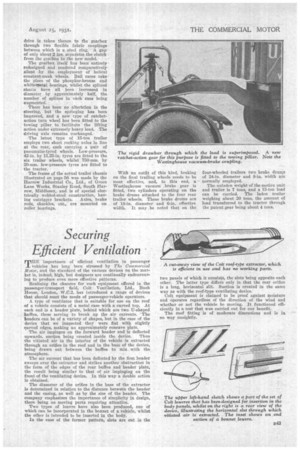Securing Efficient Ventilation
Page 57

If you've noticed an error in this article please click here to report it so we can fix it.
TUE importance of efficient ventilation in passenger vehicles has long been stressed by The Commercial Motor, and the standard of the various devices On the market is, indeed, high, but designers are continually endeavouring to produce even more effective patterns.
Realizing the chances for such equipment offered in the passenger-transport field, Colt Ventilation, Ltd., Bush Rouse, London, W.C.2, has introduced a range of devices that should meet the needs of passenger-vehicle operators.
A type of ventilator that is suitable for use on the roof of a vehicle consists of a metal case with a curved top. At each end is a header plate, behind which are two U-shaped baffles, these serving to break up the air currents. The headers can be of a variety of shapes, but in the case of the device that we inspected they were flat with slightly curved edges, making an approximately concave plate.
The air impinges on the forward header and is deflected upwards, suction being created inside the device. Thus the vitiated air in the interior of the vehicle is extracted through an orifice in the roof and in the base of the device, being drawn out between the baffles to mix with the atmosphere.
The air current that has been deflected by the first header sweeps over the extractor and strikes another obstruction in the form of the edges of the rear baffles and header plate, the result being similar to that of air impinging on the front of the ventilating device. In this way a double action is obtained.
The diameter of the orifice in the base of the extractor is determined in relation to the distance between the header and the casing, as well as by the size of the header. The company emphasizes the importance of simplicity in design, there being no moving parts requiring attention.
Two types of louvre have also been produced, one of which can be incorporated in the bonnet of a vehicle, whilst the other is intended to be inserted in the body.
In thecase of the former pattern, slots are cut in the two panels of which it consists, the slots being opposite each other. The latter type differs only in that the rear orifice is a long, horizontal slit. Suction is created in the same way as with the roof-type ventilating device. • Colt equipment is claimed to be proof against moisture and operates regardless of the direction of the wind and whether or not the vehicle be moving. It functioned efficiently in a test that was carried out for our benefit.
The roof fitting is of moderate dimensions and is in no way unsightly.




























































































